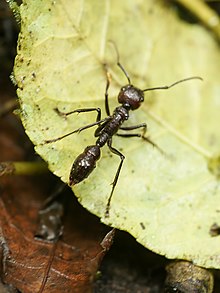Paraponera clavata
| Paraponera clavata | |
|---|---|
 |
|
| Scientific classification | |
| Kingdom: | Animalia |
| Phylum: | Arthropoda |
| Class: | Insecta |
| Order: | Hymenoptera |
| Family: | Formicidae |
| Subfamily: | Paraponerinae |
| Tribe: | Paraponerini |
| Genus: | Paraponera |
| Species: | P. clavata |
| Binomial name | |
|
Paraponera clavata (Fabricius, 1775) |
|
| Synonyms | |
|
Paraponera aculeata (Olivier, 1792) |
|
Paraponera aculeata (Olivier, 1792)
Paraponera tarsalis (Perty, 1833)
Paraponera clavata is a species of ant, commonly known as the bullet ant, named for its potent sting. It inhabits humid lowland rainforests from Nicaragua and the extreme east of Honduras and south to Paraguay.
The specific epithet of the ant, clavata, derives from clavate, in which it means "club-shaped". The generic name, Paraponera, translates to "near-Ponera". Due to its notoriety, the ant has several Indian, Spanish and Portuguese local names in different geographical areas. Perhaps the best known name is the Venezuelan hormiga veinticuatro (the "24 ant" or "24-hour ant"), referring to the full day of pain that follows being stung; it can also refer to the time it takes to kill a human. In Brazil, the Portuguese names given by locals include formiga cabo verde, formigão or formigão-preto (big black ant), and Indian-derived names are tocandera, tocandira and tocanquibira. These names derive from the Tupi–Guarani tuca-ndy, which translates to "the one wounding deeply". Other names to which it is referred include chacha, cumanagata, munuri, siámña, yolosa, and viente cuatro hora hormiga. In Costa Rica, P. clavata is known as bala, meaning "bullet".P. clavata also has several common names; it is most commonly known as the bullet ant because of the extreme pain it delivers following a sting, similar to that of getting shot. Other names are the lesser giant hunting ant and conga ant.
Paraponera clavata was first described by Danish zoologist Johan Christian Fabricius in 1775, who named it Formica clavata in his Systema entomologiae, based on a worker he collected. Fabricius incorrectly listed the type locality as India, although these ants are only found in Central and South America. In 1804, P. clavata was transferred to the genus Ponera by French zoologist Pierre André Latreille. The genus Paraponera was established by British entomologist Frederick Smith in 1858, and P. clavata was designated as the type species by monotypy (the condition of a taxonomic group having only a single taxon described). In his book, Smith would synonymise multiple taxons under Paraponera clavata, including Formica armata, Formica spininoda, Ponera tarsalis and Ponera clavata. Later publications would also synonymise more taxons, including Formica aculeata and Formica clavata. The genus was placed in a monotypic tribe, the Paraponerini, in 1901 by Italian entomologist Carlo Emery, who stressed the importance of certain morphological characteristics of Paraponera; Emery had also placed the tribe close to the Ectatommini. This classification was accepted by the entomological community until 1958, where American entomologist William Brown Jr. synonymised Paraponerini and transferred Paraponera to Ectatommini. It was treated as a valid tribe in 1994, but in 2003, English myrmecologist elevated the rank of the tribe to subfamily level as Paraponerinae, being apart of the Poneromorph subfamilies.
...
Wikipedia

